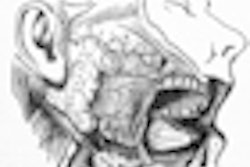Your elderly patient has been on bisphosphonate medication and needs an extraction, raising the question of whether she is at risk for bisphosphonate-related osteonecrosis of the jaw (ONJ).
The science on the incidence of bisphosphonate-related ONJ is still murky, but a new study has found that occurrences of the condition may be rare in patients receiving once-yearly infusions of 5 mg of the intravenous bisphosphonate zoledronic acid (Journal of the American Dental Association [JADA], November 2010, Vol. 141:11, pp. 1365-1370).
The study was funded by Novartis, which manufactures Zometa, a zoledronic acid bisphosphonate drug. Novartis has been involved in numerous lawsuits that it did not provide adequate warning about this side effect of its bisphosphonate drug. In addition, lead author John Grbic, DMD, is a consultant and speaker for Novartis and a member of its scientific advisory board.
In 2008, Novartis sponsored the Health Outcomes and Reduced Incidence with Zoledronic Acid Once Yearly-Pivotal Fracture Trial (HORIZON-PFT) (JADA, January 2008, Vol. 139:1, pp. 32-40), which looked at the incidence of adjudicated ONJ in postmenopausal women with osteoporosis (ages 65-89) who received zoledronic acid or a placebo over three years. The study found that ONJ occurred in one patient receiving zoledronic acid and one patient receiving a placebo.
— Peter L. Jacobsen, DDS, Arthur A.
Dugoni School of Dentistry
The study authors looked at data from HORIZON-PFT and also looked at the incidence of ONJ in four additional HORIZON clinical trials involving patients with osteopenia or osteoporosis who were treated with zoledronic acid. These four trials included randomized controlled studies in which investigators assessed the safety and efficacy of a once-yearly infusion of 5 mg of zoledronic acid.
An independent committee conducted a masked review of the four additional trials and looked at their adverse events databases for cases meeting predefined criteria for ONJ. They also collected serum CTx (S-CTx) level data for subsets of patients from these trials. Previous research has indicated that S-CTx is a potential indicator of ONJ risk in patients receiving oral bisphosphonates who require oral surgery (Journal of Bone and Mineral Research, April 2009, Vol. 24:4, pp. 561-574).
The results revealed no further cases of ONJ. The S-CTx levels commonly were lower than 0.15 nanograms per milliliter (ng/mL), with no correlation to the incidence of ONJ.
"In the clinically diverse group of 5,903 patients who received zoledronic acid in five clinical trials, ONJ incidence was less than one in 14,200 patient treatment years," the authors concluded. "Data from four clinical trials indicated that S-CTx levels lower than 0.15 ng/mL were common among patients receiving ZOL [zoledronic acid] for treatment of OP [osteoporosis] and were not associated with ONJ."
Some shortcomings
These findings are very enlightening because the studies have been well designed and actively looked for ONJ and found only one case, Marshall Wade, DDS, a diplomate of the American Board of Oral and Maxillofacial Surgery who has lectured on the topic, told DrBicuspid.com. However, he noted, it was only a three-year study.
"With oral bisphosphonates, we found that there was a three-year window before ONJ developed as a general rule, not accounting for other risks such as prednisone use," he said.
In addition, the study did not look specifically at patients having surgical procedures done.
"So until we have more of that data, dentists should proceed with extractions with more confidence in those patients within the three-year window," Dr. Wade said. "But I would still limit elective procedures like implants."
Peter L. Jacobsen, DDS, an adjunct professor at the University of the Pacific Arthur A. Dugoni School of Dentistry and a member of a panel that compiled a report on the management of patients who have been on oral bisphosphonate therapy (JADA, December 2008, Vol. 139:12, pp. 1674-1677), said that these most recent findings are in line with prior retrospective studies.
However, the prior studies were not originally designed to look at ONJ, he noted.
"The prospective studies are now in progress (and they will take place over the next two to three years)," Dr. Jacobsen told DrBicuspid.com. "Those studies are scientifically and statistically more powerful and will give us the real answers."
The current JADA study also found that low S-CTx levels had no correlation to the incidence of ONJ, and Dr. Jacobsen pointed out that the ADA expert committee and others have been saying this for a while.
"The CTX test has not been shown to provide predictive information relative to ONJ for any individual patient," he said.
Dr. Wade agreed that this particular finding was not surprising.
"Our office looked at 15 patients at four-month intervals of discontinuing their bisphosphonate meds and found absolutely no correlation to length of time off the drug and serum CTX," he said.
Invasive procedures and ONJ risk
While these findings are not particularly new, they can reduce the fear relative to ONJ and bisphosphonates, Dr. Jacobsen said.
"One in 14,000 is not a very scary number," he said. "That is not very high risk."
However, Dr. Jacobsen does recommend that general dentists consider referring patients that fall into this risk group for high-risk procedures such as extractions -- not because the oral surgeon can do a better extraction, but because they are better prepared to deal with any complications.
Dr. Wade also recommends that dentists give their patients a consent form that outlines the potential risks of bisphosphonates. In addition, it is important to ascertain whether patients have been on oral bisphosphonates prior to starting the injectable form because cumulative time of use is important, he added.
"Still, conservative dentistry has the best chance of minimizing any complications," Dr. Jacobsen concluded.
Copyright © 2010 DrBicuspid.com


















